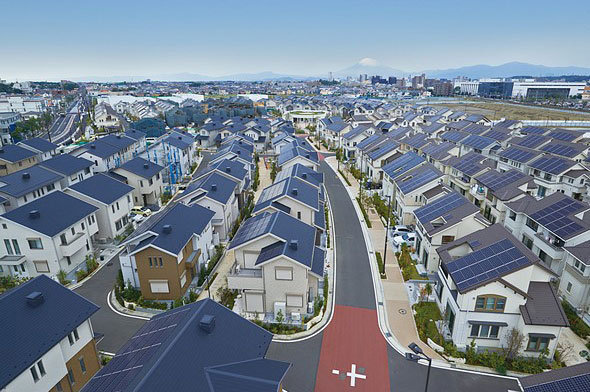What is a smart city? This is an oft-discussed topic ever since the Modi government announced the “100 smart cities mission”.
While there is no universally accepted definition, a ‘smart city’ refers to providing a city with core infrastructure, decent quality of life, and clean and sustainable environment, with the application of technology.
When Japanese electronics major Panasonic shut down its old factory site at Fujisawa, a seaside suburb about an hour from Tokyo, it had a choice either to sell the land to property developers or build a smart town utilising home-grown technology.
“Since the Great East Japan earthquake of March 2011, there has been a demand to shift to renewable energy solutions, which have a milder environmental impact,” said a spokesperson for Panasonic.
In 2007, talks began on how to use the land, and Panasonic and the local government jointly laid down the town development policy for the Fujisawa Sustainable Smart Town (SST). As many as 18 more companies came on board and formed the Fujisawa SST Town Development Council, headed by Panasonic, in 2012.
“There are over 600 ‘smart cities’ in the world,” said Masako Wada, Assistant Chief, Fujisawa SST Management Team.
“We studied many of them and found out that many conventional smart cities focussed on a high level of infrastructure, were product- and technology-oriented, and focussed on smart energy only. We chose a different way.
“We wanted to focus on the residents’ life, be service-oriented and offer not just smart energy but also smart mobility, security, wellness and community,” she added.
Going green
The 19-hecatre smart town opened up for residents in spring 2014. It aims to reduce carbon dioxide emission as well as water and energy consumption. It offers local energy generation for self consumption, CCTV surveillance, eco-friendly mobility, etc.
The township aims to house 1,000 households, and 220 have already moved in. “None of the families that moved in have left, which itself is an indicator of the success of the town,” the spokesperson added.
The entire project, slated for completion by 2018, will offer 600 detached houses and 400 condos, health and educational facilities, and a senior living project, among others.
So how are the residents living a ‘smart’ life?
Each house has a solar power generation system and storage battery units, with an option to sell the surplus to the grid.
“It is made clear to residents at the time of sale that use of solar is mandatory,” Wada said.
The entire township has CCTV surveillance, enabling a ‘virtual gated town’, offering safety without physical gates and barriers. It also offers residents sharing services for electric vehicles, EV bikes, home-delivered rental cars, and battery stations that rent out rechargeable batteries.
The town’s most interesting feature is the community platform, which includes a one-stop portal service. This allows residents to measure household energy consumption and the status of metering equipment. “Residents can also access various local services, make reservations for mobility service, etc, via this network,” Wada said.
A detached house costs $5,00,000 (approximately ₹3 crore) and the services come at $100 a month.
Long-term vision
India could perhaps learn from Fujisawa’s long-term vision. The Japanese town has laid down a 100-year timeline, from 2008 to 2108. “While 2008-18 covers construction, 2018-48 will be the town’s growth period; 2048-78 will be the maturation period and the last 30 years, i.e. till 2108, has been marked as the evolution period,” Wada added.
As more residents move into Fujisawa, Panansonic is already gearing up to participate in the development of another smart city, in Yokohama.
 |
 |
 |
 |
 |
 |
 |
 |
 |
 |
 |
 |
 |


